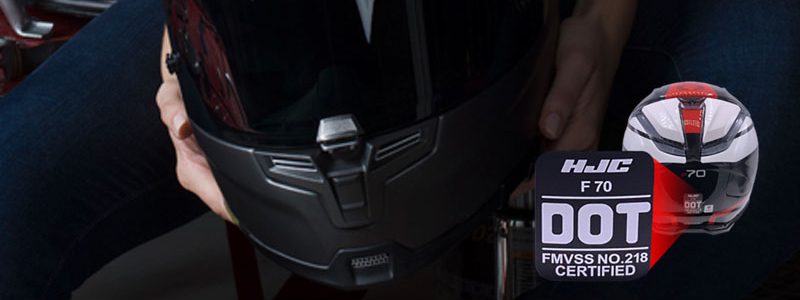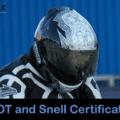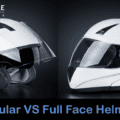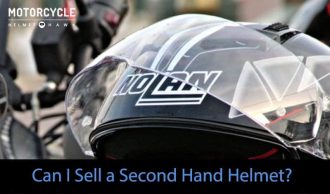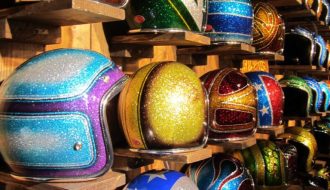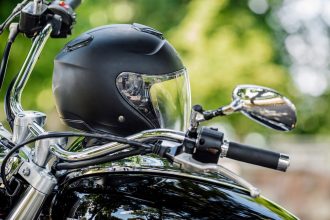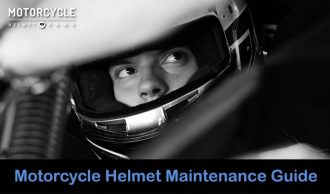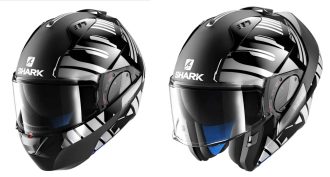Motorcycle riding is an exhilarating affair that lets you feel the open road. It also leaves you highly vulnerable to injuries if anything goes awry.
Check your helmet is certified:
View the back of the helmet for a certification label. Every jurisdiction has their own safety certifications.
That’s why ‘all the gear, all the time,’ or ATGATT, has become such a well-known phrase. And why helmets have gone from highly suggested to absolutely required.
To help you find a certified helmet, here’s what you need to know about choosing a helmet with the right safety certifications for your area.
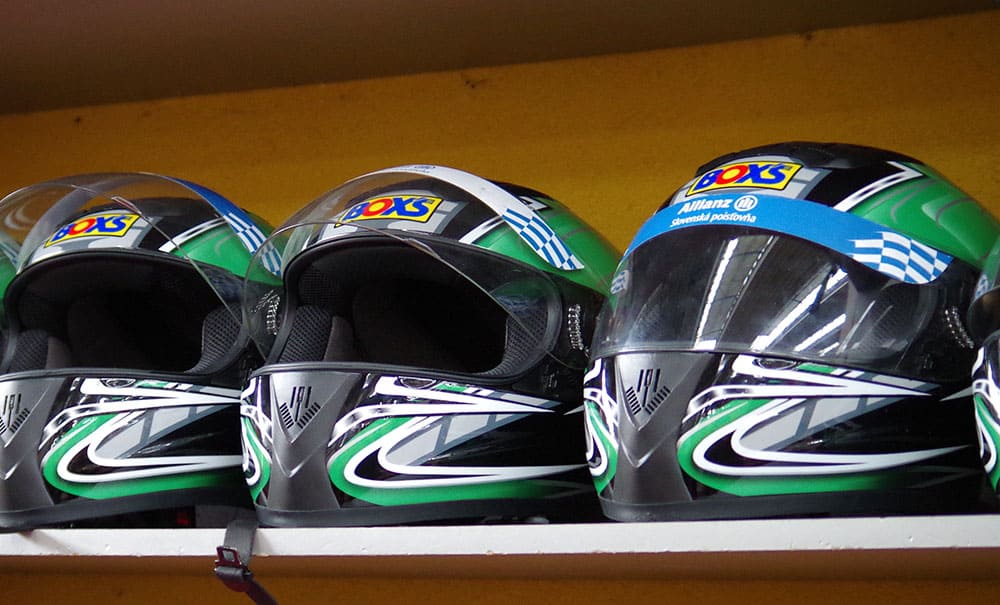
The helmet you buy at a store must be safety certified for road use
What Is Motorcycle Helmet Safety Certification?
Truly effective helmets are designed to disperse energy from an impact instead of letting it reverberate through your skull.
In order to confirm that the helmet materials can do that, each design must go through extensive safety certification testing.
These tests gauge how well the helmets absorb energy and protect the wearer’s head from suffering minor to severe injuries.
If the helmets stay intact and negate impact energy as desired, they are issued a safety certification label.
You can check for a passing grade by looking at the back of the helmet for a certification label. Every jurisdiction has their own safety certifications.
In the United States, you’ll want to look for the DOT label. In Europe, they use the ECE 22.05 standard instead.
Motorcycle helmets used for racing may only carry the SNELL label.
If the motorcycle helmet in question does not have any label at all, replace it with one that does.
There’s no guarantee that an untested helmet will protect you in even a minor collision, much less a major accident.
How Are Motorcycle Helmets Tested?
Motorcycle helmet testing works a lot like crash tests for automobiles. Depending on the jurisdiction, the helmets are secured to a jig that can raise and lower its arm at various speeds.
The jig then smashes the helmet down against an anvil to see how well it can handle the energy of the impact.
Oftentimes, the tests involve several anvils in different shapes and repeat impacts to best simulate what could happen in a crash.
After each test, the testing crew inspects the helmet for damage and rates its ability to provide the ideal level of protection.
They will also look beyond its ability to handle impacts to its susceptibility to penetration and other types of damage.
They might even look at the visibility rating of the face shield and ease of removal after a collision occurs.
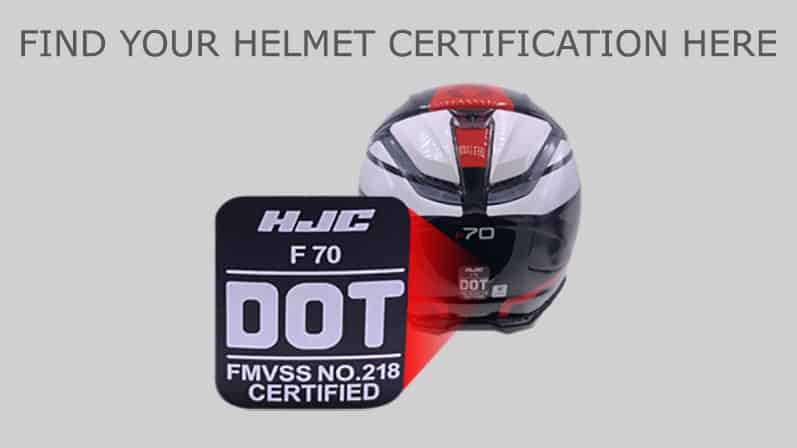
Related: What does DOT and Snell Certification All Mean?
DOT vs. SNELL vs. ECE Certification
Every jurisdiction has their own idea of what makes for a perfectly safe motorcycle helmet.
Although their standards are similar, they do not use the exact same testing procedures nor issue the same certifications.
Here’s how they differ.
DOT

The Department of Transportation, or DOT, standards used in the United States are some of the strictest of the bunch.
Since motorcycle crash speeds are often rather high in the US, they send the jig sailing down toward the anvil much faster than other testing entities do.
Overall, they are focused on certifying motorcycle helmets that perform beyond the standards for impact and penetration resistance, visibility, and retention.
The testing is random, however, so some models may slip through the cracks.
Of the ones that are tested, all the testing procedures are thoroughly documented and repeated to minimize the risk of making the wrong call.
The testing protocols have not changed much over the years though, leaving some room for improvement.
ECE

All across Europe, the Economic Commission for Europe, or ECE, standards are used for motorcycle helmet safety certifications.
Their standards are newer and focused on not only protecting riders in a crash but collision prevention as well.
They put more emphasis on creating helmets with excellent visibility through the face shield and strong chin straps that keep the gear in place.
All across Europe, every helmet model to hit the market must go through ECE testing to earn a safety certification label.
The tests are not as intense as DOT standards necessitate, leaving the helmet hitting the anvil at much lower speeds.
They also fail to do repeated blows to the helmet. Without that level of testing, there’s no telling how ECE helmets might perform in high-speed collisions or ones that cause multiple blows to the head.
SNELL

Since motorcycle racing often reaches much higher speeds than US and European speed limits allow, they require safety certifications all their own.
To accomplish that goal, the SNELL Memorial Foundation set about creating standards that would protect racers from harm.
They focus on impact resistance, first and foremost, by using an edge anvil and dual blows. Helmets only pass if they transfer minimal energy through the shell and inner materials.
During testing, they may also repeat the blows at potential weak points, like where the visor connects.
Then, they make sure that the helmets are easy to remove in an emergency and stay stable while riding. They also go above and beyond by deconstructing the helmet to examine the material inside.
When helmets pass the safety certification testing procedures, they earn the associated label and are considered safe to use on the road or track.
If they fail to meet the standards, the manufacturer has to go back to the drawing board and try again at making a safe and secure helmet.
Related: Motorcycle Helmet Safety: Are Half-Helmets Safe?
Are DOT-Approved Helmets Safe Everywhere?
- Yes, DOT-approved helmets are considered safe basically everywhere
They are the gold standard all across the United States, of course. In Canada, they are accepted as safe, as are SNELL and ECE 22.05 helmets.
European countries allow you to use any DOT, ECE, or SNELL-certified helmets of your choice without a problem.
Is It Possible To Use ECE 22.05-Approved Helmets In All Areas?
ECE 22.05-approved helmets are not as widely accepted. When riding in the United States, you must wear a helmet with the DOT safety certification label or risk getting a ticket.
Helmets with just a ECE 22.05 label do not meet US standards unless they have the DOT label as well. Thankfully, most helmets sold in the US have both.
If you’re riding in Canada or anywhere in Europe, just the ECE label is fine.
Related: How Long Does a Motorcycle Helmet Last?
How You Can Tell If A Helmet Is Safe To Use
When buying a new helmet, you can tell it is safe to use by looking for the safety certification along the back.
If it has that label, you know it meets the safety motorcycle helmet standards set in place by your jurisdiction.
Beyond that, you need to make sure the helmet fits well and that the strap stays secured under your chin.
To check its fit, put the helmet on securely, and then move your head in every direction. If it doesn’t shift around, you’re likely good to go.
Also, remember to never use a helmet after it has been in an accident.
Even if the impact was minor, you’ll need to replace your helmet with a new one that has the proper safety certifications.
Related: What about a Second Hand Motorcycle Helmet?
Looking for a Replacement Helmet? Here’s a Recommendation
| Best Full-Face Motorcycle Helmet | Price | Rating |
|---|---|---|
| 5/5 rubber chickens | ||
| 4.8/5 rubber chickens | ||

